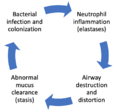Bronchiectasis facts for kids
Bronchiectasis is a lung condition where the airways in your lungs, called bronchi, become damaged and wider than they should be. This damage makes it hard for your lungs to clear out mucus. It can also cause inflammation, which means the airways get swollen and irritated.
Contents
What Are the Signs of Bronchiectasis?
If someone has bronchiectasis, they might notice a few things.
- They often have a cough that just doesn't go away. About 9 out of 10 people with this condition have a long-lasting cough.
- Many people, about 3 out of 4, cough up a lot of thick mucus, also known as sputum. This mucus can be green or pale yellow. Coughing a lot can make you feel very tired.
- Some people might feel pain in their chest.
- Sometimes, people with bronchiectasis might even cough up a little blood. This is called haemoptysis.
- Other signs can include bad breath or sinusitis (a sinus infection) that keeps coming back.
Different Kinds of Bronchiectasis
There are three main types of bronchiectasis, named after how the damaged airways look:
- Cylindrical bronchiectasis: The airways are widened evenly, like a cylinder.
- Varicose bronchiectasis: The airways look bumpy, like varicose veins.
- Saccular or cystic bronchiectasis: This is the most serious type. The airways have large, balloon-like sacs. This type is often seen in people who also have cystic fibrosis, another lung disease.
What Causes Bronchiectasis?
Sometimes, people are born with bronchiectasis. Other times, they develop it later in life. Doctors can find a specific cause in about 4 out of 10 cases.
Some things can make a person more likely to get bronchiectasis:
- People who have rheumatoid arthritis (a condition that causes joint pain) and also smoke are much more likely to develop it.
- A rare genetic condition called alpha 1-antitrypsin deficiency can also increase the risk, but scientists are still learning why.
How Do Doctors Find Bronchiectasis?
Doctors usually diagnose bronchiectasis using a special X-ray called a CT scan. This scan takes detailed pictures of the inside of your body, including your lungs.
How Is Bronchiectasis Treated?
The main goal of treatment is to help clear the mucus from the lungs and stop infections.
- Doctors often prescribe antibiotics to treat or prevent lung infections.
- Other medicines can also be used to help with symptoms.
- Sometimes, if the damage is severe in one part of the lung, surgery might be needed to remove that section.
History of Bronchiectasis
The first time bronchiectasis was described by a doctor was in 1819. A French doctor named René Laennec wrote about it.
Images for kids
-
Bronchiectasis primarily in the middle lobe of the right lung.
See also
 In Spanish: Bronquiectasia para niños
In Spanish: Bronquiectasia para niños





